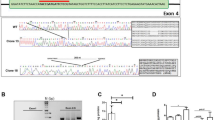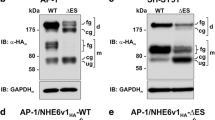Abstract
C282Y and H63D are two common variants of the hemochromatosis protein HFE. SH-SY5Y human neuroblastoma cells stably transfected to express either wild type HFE (WT-HFE), or the C282Y or H63D allele were analyzed for effect of expression of the mutant proteins on transcription of 14 enzymes involved in sphingolipid metabolism. Cells expressing the C282Y variant showed significant increases (>2-fold) in transcription of five genes and decreases in two compared to that seen for cells expressing WT-HFE, while cells expressing the H63D variant showed an elevation in transcription of one gene and a decrease in two. These changes were seen as alterations in ganglioside composition, cell surface binding by the binding subunit of cholera toxin, expression of sphingosine-kinase-1 and synthesis of sphingosine-1-phosphate. These changes may explain why C282Y-HFE is a risk factor for colon and breast cancer and possibly protective against Alzheimer’s disease while H63D-HFE is a risk factor for neurodegenerative diseases.







Similar content being viewed by others
References
Goswami T, Andrews NC (2006) Hereditary hemochromatosis protein, HFE, interaction with transferrin receptor 2 suggests a molecular mechanism for mammalian iron sensing. J Biol Chem 281:28494–28498
Combarros O, Garcia-Roman M, Fontalba A et al (2003) Interaction of the H63D mutation in the hemochromatosis gene with the apolipoprotein E epsilon 4 allele modulates age at onset of Alzheimer’s disease. Dement Geriatr Cogn Disord 15:151–154
Connor JR, Lee SY (2006) HFE mutations and Alzheimer’s disease. J Alzheimers Dis 10:267–276
Osborne NJ, Gurrin LC, Allen KJ et al (2010) HFE C282Y homozygotes are at increased risk of breast and colorectal cancer. Hepatology 51:1311–1318
Correia AP, Pinto JP, Dias V et al (2009) CAT53 and HFE alleles in Alzheimer’s disease: a putative protective role of the C282Y HFE mutation. Neurosci Lett 457:129–132
Waheed A, Parkkila S, Zhou XY et al (1997) Hereditary hemochromatosis: effects of C282Y and H63D mutations on association with beta2-microglobulin, intracellular processing, and cell surface expression of the HFE protein in COS-7 cells. Proc. Natl. Acad. Sci. USA 94:12384–12389
Lawless MW, Mankan AK, White M et al (2007) Expression of hereditary hemochromatosis C282Y HFE protein in HEK293 cells activates specific endoplasmic reticulum stress responses. BMC Cell Biol 8:30
Feder JN, Penny DM, Irrinki A et al (1998) The hemochromatosis gene product complexes with the transferrin receptor and lowers its affinity for ligand binding. Proc Natl Acad Sci USA 95:1472–1477
Calzolari A, Raggi C, Deaglio S et al (2006) TfR2 localizes in lipid raft domains and is released in exosomes to activate signal transduction along the MAPK pathway. J Cell Sci 119:4486–4498
Chen J, Chloupkova M, Gao J et al (2007) HFE modulates transferrin receptor 2 levels in hepatoma cells via interations that differ from transferrin receptor 1-HFE interactions. J Biol Chem 282:36862–36870
Simons K, Ikonen E (1997) Functional rafts in cell membranes. Nature 387:569–572
Sakiyama H, Robbins PW (1973) Glycolipid synthesis and tumorigenicity of clones isolated from the Nil 2 line of hamster embryo fibroblasts. Fed Proc 32:86–90
Brady RO, Fishman PH, Mora PT (1973) Membrane components and enzymes in virally transformed cells. Fed Proc 32:102–108
Hakomori S (1981) Glycosphingolipids in cellular interaction, differentiation, and oncogenesis. Ann Rev Biochem 50:733–764
Petro KA, Schengrund C-L (2009) Membrane raft disruption promotes axonogenesis in N2a neuroblastoma cells. Neurochem Res 34:29–37
Ruckhaberle E, Karn T, Rody A et al (2009) Gene expression of ceramide kinase, galactosyl ceramide synthase and ganglioside GD3 synthase is associated with prognosis in breast cancer. J Cancer Res Clin Oncol 135:1005–1013
Fantini J, Barrantes FJ (2009) Sphingolipid/cholesterol regulation of neurotransmitter receptor conformation and function. Biochim Biophys Acta 1788:2345–2361
Miyagi T, Wada T, Yamaguchi K et al (2008) Plasma membrane-associated sialidase as a crucial regulator of transmembrane signalling. J Biochem 144:279–285
Allende ML, Proia RL (2002) Lubricating cell signaling pathways with gangliosides. Curr Opin Struct Biol 12:587–592
Yamamoto N, Hirabayashi Y, Amari M et al (2005) Assembly of hereditary amyloid beta-protein variants in the presence of favorable gangliosides. FEBS Lett 579:2185–2190
Yamamoto N, Matsuzaki K, Yanagisawa K (2005) Cross-seeding of wild-type and hereditary variant-type amyloid beta-proteins in the presence of gangliosides. J Neurochem 95:1167–1176
Yanagisawa M, Ariga T, Yu RK (2010) Cytotoxic effects of G(M1) ganglioside and amyloid beta-peptide on mouse embryonic neural stem cells. ASN Neuro 2:e00029
Tamboli IY et al (2005) Inhibition of glycosphingolipid biosynthesis reduces secretion of the ß-amyloid precursor protein and amyloid ß-peptide. J Biol Chem 280:28110–28117
Cecchi C, Nichino D, Zampagni M et al (2009) A protective role for lipid raft cholesterol against amyloid-induced membrane damage in human neuroblastoma cells. Biochim Biophys Acta 1788:2204–2216
Wang XS, Lee S, Simmons Z et al (2004) Increased incidence of the HFE mutation in amyotropic lateral sclerosis and related cellular consequences. J Neural Sci 227:27–33
Lee SY, Patton SM, Henderson RJ et al (2007) Consequences of expressing mutants of the hemochromatosis gene (HFE) into a human neuronal cell line lacking endogenous HFE. FASEB J 21:564–576
Petro KA, Dyer MA, Yowler BC et al (2006) Disruption of lipid rafts enhances activity of botulinum neurotoxin serotype A. Toxicon 48:1035–1045
Kasperzyk JL, d’Azzo A, Platt FM et al (2005) Substrate reduction reduces gangliosides in postnatal cerebrum-brainstem and cerebellum in GM1 gangliosidosis mice. J Lipid Res 46:744–751
Svennerholm L (1957) Quantitative estimation of sialic acids. II. A colorimetric resorcinol-hydrochloric acid method. Biochim Biophys Acta 24:604–611
Suetake K, Yu RK (2003) Thin-layer chromatography; immunostaining of glycolipid antigens; and interpretation of false-positive findings with acidic lipids. Methods Enzymol 363:312–319
Hengst JA, Guilford JM, Conroy EJ et al (2010) Enhancement of sphingosine kinase 1 catalytic activity by deletion of 21 amino acids from the COOH-terminus. Arch Biochem Biophys 494:23–31
Hengst JA, Guilford JM, Fox TE et al (2009) Sphingosine kinase 1 localized to the plasma membrane lipid raft microdomain overcomes serum deprivation induced growth inhibition. Arch Biochem Biophys 492:62–73
Bickel PE, Scherer PE, Schnitzer JE et al (1997) Flotillin and epidermal surface antigen define a new family of caveolae-associated integral membrane proteins. J Biol Chem 272:13793–13802
Johnstone SR, Stallcup WB (1988) Altered expression of D1.1 ganglioside in the cerebellum of the Weaver mouse. J Neurochem 51:1655–1657
Purpura DP, Baker HJ (1978) Meganeurites and other aberrant processes of neurons in feline GM1-gangliosidosis: a Golgi study. Brain Res 116:1–21
Yanagisawa M, Ariga T, Yu RK (2006) Cholera toxin B subunit binding does not correlate with GM1 expression: a study using mouse embryonic neural precursor cells. Glycobiology 16:19G–22G
Cuvillier O, Ader I, Bouquerel P et al (2010) Activation of sphingosine kinase-1 in cancer: implications for therapeutic targeting. Curr Mol Pharmacol 3:53–65
Duchemin AM, Ren Q, Neff NH et al (2008) GM1-induced activation of phosphatidylinositol 3-kinase: involvement of Trk receptors. J Neurochem 104:1466–1477
Kwak DH, Yu K, Kim SM et al (2006) Dynamic changes of gangliosides expression during the differentiation of embryonic and mesenchymal stem cells into neural cells. Exp Mol Med 38:668–676
Wu G, Xie X, Lu ZH et al (2009) Sodiium-calcium exchanger complexed with GM1 ganglioside in nuclear membrane transfers calcium from nucleoplasm to endoplasmic reticulum. Proc Natl Acad Sci USA 106:10829–10834
Rosner H (1982) Ganglioside changes in the chicken optic lobes as biochemical indicators of brain development and maturation. Brain Res 236:49–61
Kabayama K, Sato T, Saito K et al (2007) Dissociationof the insulin receptor and caveolin-1 complex by ganglioside GM3 in the state of insulin resistance. Proc Natl Acad Sci USA 104:13678–13683
Van Brocklyn J, Bremer EG, Yates AJ (1993) Gangliosides inhibit platelet-derived growth factor-stimulated receptor dimerization in human glioma U-1242MG and Swiss 3T3 cells. J Neurochem 61:371–374
Mutoh T, Tokuda A, Miyadai T (1995) Ganglioside GM1 binds to the Trk protein and regulates receptor function. Proc Natl Acad Sci USA 92:5087–5091
Rusnati M, Urbinati C, Tanghetti E et al (2002) Cell membrane ganglioside GM1 ganglioside is a functional coreceptor for fibroblast growth factor 2. Proc Natl Acad Sci USA 99:4367–4372
Kuziemko GM, Stroh M, Stevens RC (1996) Cholera toxin binding affinity and specificity for gangliosides determined by surface Plasmon resonance. Biochemistry 35:6375–6384
Van Brocklyn JR, Jackson CA, Pearl DK et al (2005) Sphingosine kinase-1 expression correlates with poor survival of patients with glioblastoma multiforme: roles of sphingosine kinase isoforms in growth of glioblastoma cell lines. J Neuropathol Exp Neurol 64:695–705
Ruckhaberle E, Rody A, Engels K et al (2008) Microarray analysis of altered sphingolipid metabolism reveals prognostic significance of sphingosine kinase 1 in breast cancer. Breast Cancer Res Treat 112:41–52
Brizuela L, Dayon A, Doumerc N et al (2010) The sphingosine kinase-1 survival pathway is a molecular target for the tumor-suppressive tea and wine polyphenols in prostate cancer. FASEB J 24:3882–3894
Lee SY, Liu S, Mitchell RM et al (2010) HFE polymorphisms influence the response to chemotherapeutic agents via induction of p16INK4A. Int J Cancer. doi:10.1002/ijc.25888
Chumanevich AA, Poudyal D, Cui X et al (2010) Suppression of colitis-driven colon cancer in mice by a novel small molecule inhibitor of sphingosine kinase. Carcinogenesis 31:1787–1793
Kapitonov D, Allegood JC, Mitchell C et al (2009) Targeting sphingosine kinase 1 inhibits Akt signaling, induces apoptosis, and suppresses growth of human glioblastoma cells and xenografts. Cancer Res 69:6915–6923
Madhankumar AB, Slagle-Webb B, Wang X et al (2009) Efficacy of IL-13 receptor targeted liposomal doxorubicin in the intracranial brain tumor model. Mol Cancer Ther 8:648–654
Svennerholm L (1980) Ganglioside designation. Adv Exp Med Biol 125:11
Acknowledgments
The authors thank Dr. Jong Yun for helpful discussions, Dr. K.A. Petro for her help with isolating lipid rafts, and Dr. Sang Lee for providing us with the SH-SY5Y cells stably transfected to express either FLAG-tagged WT-, H63D- or C282Y-HFE alleles. We also thank the Jake Gittlen Cancer Research Foundation (JAH), and the George M. Leader Family Corporation (JRC) for their support.
Author information
Authors and Affiliations
Corresponding author
Additional information
Special Issue: In Honor of Dr. Robert Yu.
Rights and permissions
About this article
Cite this article
Ali-Rahmani, F., Hengst, J.A., Connor, J.R. et al. Effect of HFE Variants on Sphingolipid Expression by SH-SY5Y Human Neuroblastoma Cells. Neurochem Res 36, 1687–1696 (2011). https://doi.org/10.1007/s11064-011-0403-8
Accepted:
Published:
Issue Date:
DOI: https://doi.org/10.1007/s11064-011-0403-8




